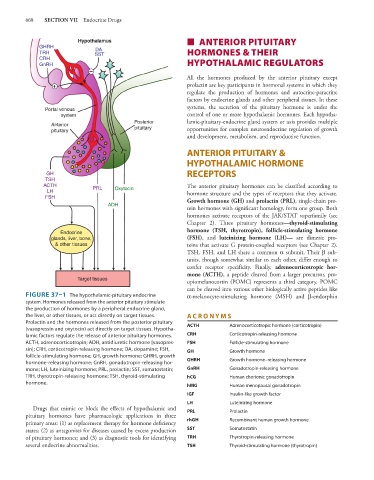Page 682 - Basic _ Clinical Pharmacology ( PDFDrive )
P. 682
668 SECTION VII Endocrine Drugs
Hypothalamus ■ ANTERIOR PITUITARY
GHRH DA
TRH SST HORMONES & THEIR
CRH
GnRH HYPOTHALAMIC REGULATORS
–
All the hormones produced by the anterior pituitary except
+ prolactin are key participants in hormonal systems in which they
regulate the production of hormones and autocrine-paracrine
factors by endocrine glands and other peripheral tissues. In these
systems, the secretion of the pituitary hormone is under the
Portal venous
system control of one or more hypothalamic hormones. Each hypotha-
Posterior lamic-pituitary-endocrine gland system or axis provides multiple
Anterior
pituitary pituitary opportunities for complex neuroendocrine regulation of growth
and development, metabolism, and reproductive function.
ANTERIOR PITUITARY &
HYPOTHALAMIC HORMONE
GH RECEPTORS
TSH
ACTH PRL The anterior pituitary hormones can be classified according to
LH Oxytocin hormone structure and the types of receptors that they activate.
FSH Growth hormone (GH) and prolactin (PRL), single-chain pro-
ADH
tein hormones with significant homology, form one group. Both
hormones activate receptors of the JAK/STAT superfamily (see
Chapter 2). Three pituitary hormones—thyroid-stimulating
Endocrine hormone (TSH, thyrotropin), follicle-stimulating hormone
glands, liver, bone, (FSH), and luteinizing hormone (LH)— are dimeric pro-
& other tissues teins that activate G protein-coupled receptors (see Chapter 2).
TSH, FSH, and LH share a common α subunit. Their β sub-
units, though somewhat similar to each other, differ enough to
confer receptor specificity. Finally, adrenocorticotropic hor-
mone (ACTH), a peptide cleaved from a larger precursor, pro-
Target tissues
opiomelanocortin (POMC) represents a third category. POMC
can be cleaved into various other biologically active peptides like
FIGURE 37–1 The hypothalamic-pituitary endocrine α-melanocyte-stimulating hormone (MSH) and β-endorphin
system. Hormones released from the anterior pituitary stimulate
the production of hormones by a peripheral endocrine gland,
the liver, or other tissues, or act directly on target tissues. A CR ON Y MS
Prolactin and the hormones released from the posterior pituitary ACTH
(vasopressin and oxytocin) act directly on target tissues. Hypotha- Adrenocorticotropic hormone (corticotropin)
lamic factors regulate the release of anterior pituitary hormones. CRH Corticotropin-releasing hormone
ACTH, adrenocorticotropin; ADH, antidiuretic hormone [vasopres- FSH Follicle-stimulating hormone
sin]; CRH, corticotropin-releasing hormone; DA, dopamine; FSH, GH Growth hormone
follicle-stimulating hormone; GH, growth hormone; GHRH, growth
hormone-releasing hormone; GnRH, gonadotropin-releasing hor- GHRH Growth hormone–releasing hormone
mone; LH, luteinizing hormone; PRL, prolactin; SST, somatostatin; GnRH Gonadotropin-releasing hormone
TRH, thyrotropin-releasing hormone; TSH, thyroid-stimulating hCG Human chorionic gonadotropin
hormone. hMG Human menopausal gonadotropin
IGF Insulin-like growth factor
LH Luteinizing hormone
Drugs that mimic or block the effects of hypothalamic and PRL
pituitary hormones have pharmacologic applications in three Prolactin
primary areas: (1) as replacement therapy for hormone deficiency rhGH Recombinant human growth hormone
states; (2) as antagonists for diseases caused by excess production SST Somatostatin
of pituitary hormones; and (3) as diagnostic tools for identifying TRH Thyrotropin-releasing hormone
several endocrine abnormalities. TSH Thyroid-stimulating hormone (thyrotropin)

